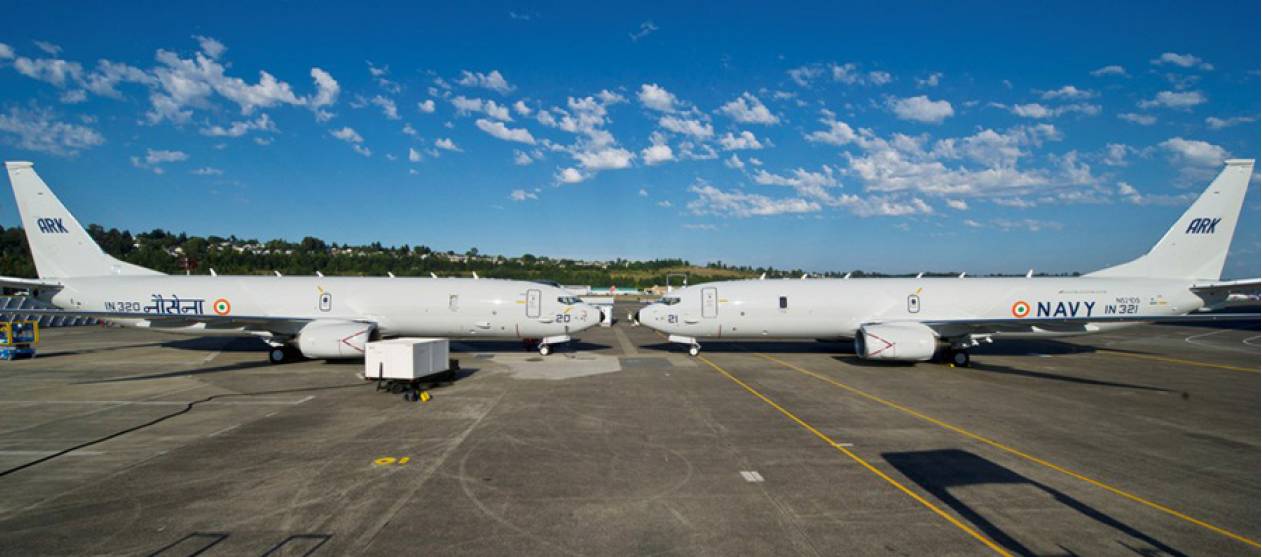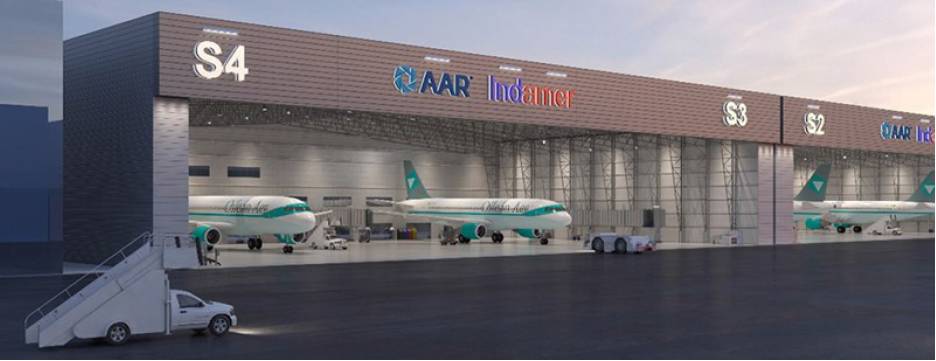AEROSPACE MRO in India
Keeping it in-country
Despite the pandemic, India’s MRO sector is looking to a bright future with more commercial work undertaken locally and a military with an increasing appetite for outsourcing to the private sector. NEELAM MATHEWS reports on the changes.
 Air Works India, with Boeing, has carried out the first heavy maintenance check on the Indian Navy’s Boeing P-8I sub-hunters. Boeing Defense
Air Works India, with Boeing, has carried out the first heavy maintenance check on the Indian Navy’s Boeing P-8I sub-hunters. Boeing Defense
Antagonistic policies in India in the past towards the maintenance repair and overhaul (MRO) industry have now given way to a benign environment following a substantial reduction in taxes from 18% to 5% and a favourable policy since March 2020 when the pandemic struck. Unlike in past decades, when around 90% of commercial aircraft were sent to neighbouring countries, including Singapore, Jordan, Dubai and Malaysia for repair, once the ‘old normal’ of flying returns, Indian MROs are ramping up to serve the domestic market and neighbouring countries.
Local MROs are also looking to innovate and to establish and strengthen foreign partnerships that bring with them experience, expertise in processes and international certifications. As budgets get constrained for the military, there is a move to outsource MRO to civil third-party MRO providers, providing additional opportunities in rough times. Areas in which the Indian Air Force (IAF) is looking to the private industry include: airframe and aero engines, mechanical rotables, electronic rotables, test equipment, ground support equipment, and airfield safety systems, according to an Indian MoD report.
“India is a significant market. Offsets provide an opportunity for OEMs to partner with local MROs and develop our capabilities. The challenge lies in choosing a partner capable of sustaining the business,” said a Safran India official.
Looking for a partner
Faced with ageing and crash-prone twin-engine Antonov An-32 ‘Cline’ transporters, the IAF has been looking to partner with industry for their refurbishment and re-equipment. Eleven work packages selected include: repainting, wingstructure modification, and ultrasonic inspection. A request for information (RFI) aimed at collecting information about the capabilities of various Indian suppliers has been released.
 Air India Engineering Services Ltd (AIESL), a subsidiary of government-owned Air India, has an inherent advantage for getting military business as clearances are given easily with both being state bodies, an engineer told AEROSPACE.
Air India Engineering Services Ltd (AIESL), a subsidiary of government-owned Air India, has an inherent advantage for getting military business as clearances are given easily with both being state bodies, an engineer told AEROSPACE.
AIESL has made a start, with the model type having completed a successful trial on air coolers of the An-32 for the IAF. “We are convinced we can do it,” HR Jagannath, the recently retired CEO who turned AIESL around to a profit centre, told AEROSPACE. A second trial run is to be done, to be followed by a contract, he added. The IAF also subcontracted for three years two Boeing 777s VIP aircraft for the prime minister and president to AIESL in October 2020. AIESL did modifications on the aircraft and is competent to carry out heavy maintenance D checks on the 777s where the aircraft is stripped for inspection and overhaul.
In mid-2020, Pratt & Whitney and AIESL announced a partnership to provide MRO services to support P&W’s geared turbofan (GTF) engines. AIESL will service PW1100G-JM engines, which power the Airbus A320neo, at its facility in Mumbai in a phased approach, starting with engine upgrades and module exchange capabilities. The facility has already received its first GTF engine, Jagannath said.
Other companies too are at the forefront of MRO. Air Works India, which claims to be the largest MRO in India, in partnership with Boeing, completed the first heavy maintenance check for the Indian Navy’s first multimission maritime patrol aircraft P-8I, a 737platform, in 2019. India awarded Boeing a three-year contract to continue supporting the Indian Navy’s P-8I fleet, not only through ‘field and logistics service representatives’ but also ‘engineering’, ‘planning’ and ‘robust material support.’ Of twelve ordered aircraft, India has received nine.
Finding the right service
The Indian Navy has not lost time tapping into private support. “We found the P-8I tyres were wearing out fast because of hard landings. Now they don Indian tyres,” said Retd. Rear Admiral DM Sudan, also a naval aviator. He added the IN went to the private sector for training and has tied up with CFM in Hyderabad for its CFM56-7 engines.
Even as the Indian military looks at leasing aircraft, lessors will start to look at MROs with experience and certifications. “Air Works has presence in the asset management business through its subsidiary Acumen that works closely with global lessors,” said Anand Bhaskar, Managing Director and Chief CEO, Air Works India. “We are quite keen and following this development,” he adds.
 Chicago-based AAR Corp and India’s Indamer have joined together and may turn India’s MRO misfortunes around. AAR
Chicago-based AAR Corp and India’s Indamer have joined together and may turn India’s MRO misfortunes around. AAR
The pandemic has resulted in tough times. The company has in the past decade looked at expanding its business in the West. For instance, it acquired a majority stake in the UK’s Air Livery. With the MRO industry ailing, Bhaskar said: “Our review of our erstwhile investments has been part of a carefully calibrated strategy to capitalise upon the emergence of the Asia-Pacific region as the future hub for aviation. This includes the growth in the domestic Indian civil aviation market.” The company is presently focused on starting operations at its new base maintenance facility in Kochi, South India. “The pandemic notwithstanding, the new facility will augment Air Works base maintenance hangar capacity by 50%,” explained Bhaskar.
It is AAR-Indamer Technics Pvt Ltd, a joint venture between Chicago-based AAR Corp and India’s Indamer, that is likely to turn India’s MRO misfortunes around. “This is AAR’s seventh facility worldwide,” said Rajeev Gupta, CEO. Ready for launch early in 2021, the facility is based at Nagpur in the state of Maharashtra, of which Mumbai is the capital. The launch customer of the JV is India’s largest budget carrier IndiGo which has a fleet of 240 A320 family aircraft. The new MRO facility will initially be comprised of six narrow-body bays, including one bay for paint. A training school under Indamer’s CAR 147 certification and the government of India’s Skill Development Programme will allow many students to gain skill sets. Additional phases of construction include eight new bays.
Increasing quality, saving costs
Gupta is adamant that the company will not fight competition on price but on quality: “AAR is the ideal partner for us and brings the knowledge and processes needed to help establish in-country capability and jobs in aircraft heavy maintenance.”
He adds that, with the facility based in a special economic zone, a duty-free enclave and deemed to be foreign territory for the purposes of trade operations and duties and tariffs, it will prove a boon for airlines that ferry their aircraft abroad by saving them time and fuel costs.
Gupta is also confident that more military business will come his way. With Boeing having delivered all 22 AH-64E Apache attack helicopters and 15 Chinook helicopters in July 2020 to the IAF, Gupta says the company will start talks with Boeing by the end of 2021 for their maintenance. He adds: “AAR provides depot airframe maintenance and depot field team support of the P-8I fleet for the navy, the government of Australia, and foreign military sales (FMS) customers, as well as in the US for the Apaches and Chinooks.” This experience, he says, could prove beneficial.
 Air Works India, with Boeing, has carried out the first heavy maintenance check on the Indian Navy’s Boeing P-8I sub-hunters. Boeing Defense
Air Works India, with Boeing, has carried out the first heavy maintenance check on the Indian Navy’s Boeing P-8I sub-hunters. Boeing Defense Air India Engineering Services Ltd (AIESL), a subsidiary of government-owned Air India, has an inherent advantage for getting military business as clearances are given easily with both being state bodies, an engineer told AEROSPACE.
Air India Engineering Services Ltd (AIESL), a subsidiary of government-owned Air India, has an inherent advantage for getting military business as clearances are given easily with both being state bodies, an engineer told AEROSPACE.